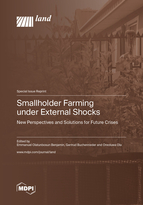Smallholder Farming under External Shocks: New Perspectives and Solutions for Future Crises
A special issue of Land (ISSN 2073-445X). This special issue belongs to the section "Land Socio-Economic and Political Issues".
Deadline for manuscript submissions: closed (20 April 2023) | Viewed by 31890
Special Issue Editors
Interests: climate-smart agriculture and aquaculture; bioeconomy; sustainable and conservation agriculture; women’s empowerment; integrated pest management
Interests: social capital; empowerment; sustainable and rural development; development economics; human security
Special Issue Information
Dear Colleagues,
Smallholder agriculture, agroforestry and aquaculture systems are vital for food supply and income generation in rural and urban areas of developing and developed countries. Smallholder systems are also an important means of livelihood through subsistence production for vulnerable groups. While smallholder farming has been viewed as inefficient for decades, more recently it has experienced a renaissance as a way of achieving the Sustainable Development Goals (SDGs) and human security, stabilizing fragile supply and value chains and volatile prices, and building ecosystem resilience, resulting in fairness and equity for all. The impact of external shocks such as climate change, the COVID-19 pandemic, and the Ukraine–Russia war will likely have long-lasting effects on smallholder and societal well-being at large. For smallholder farmers, such external shocks exacerbate the already-existing factor (e.g., capital, land, water, inputs) and institutional constraints (e.g., gender roles, land tenure). While urban and rural smallholders are innovative in adopting adaptive and/or coping strategies prior to and during external shocks, these strategies and their effectiveness are under-researched.
This Special Issue (SI) explores adaptive and coping strategies of smallholder farmers experiencing external shocks, exemplified by climate change, the recent COVID-19 pandemic, and the Ukraine–Russia war. These external shocks can adversely directly affect the productivity of agricultural land through, e.g. a higher frequency of extreme weather events and lack of access to inputs through interrupted supply chains, such as mineral fertilizer or feed. Ultimately, these shocks tremendously reduce the environmental, social, economic (sustainability), and biodiversity benefits to society. This SI provides a broad overview of theoretical-, empirical-, and field-research-based evidence from developing and developed countries regarding these issues. It emphasizes the lessons learned and the applicability of diverse strategies for ensuring crisis-proof food systems in urban and rural areas of developed and developing countries.
This SI aims to answer the following questions regarding smallholders in developing and developed countries:
- What are the impacts of external shocks such as climate change, the COVID-19 pandemic, and the Ukraine–Russia war on smallholders in (peri-)urban and rural areas engaged in agriculture, agroforestry, and aquaculture?
- What adaptive and coping strategies are used by smallholders to mitigate the impact of these external shocks?
- Which of the strategies used were most effective in cushioning the adverse effects of the external shocks on livelihoods, specifically as it concerns environmental, social, economic (sustainability), and biodiversity benefits derived from agricultural land?
- What government policies and measures were used, and how effective were they in reducing the adverse effects of the external shocks on smallholder livelihoods in relation to their agricultural land?
- What opportunities are there for smallholder farming and agricultural land due to external shocks as well as corresponding food price inflation arising from interruptions in national and international supply and value chains?
Dr. Emmanuel Olatunbosun Benjamin
Prof. Dr. Gertrud Buchenrieder
Dr. Oreoluwa Ola
Guest Editors
Manuscript Submission Information
Manuscripts should be submitted online at www.mdpi.com by registering and logging in to this website. Once you are registered, click here to go to the submission form. Manuscripts can be submitted until the deadline. All submissions that pass pre-check are peer-reviewed. Accepted papers will be published continuously in the journal (as soon as accepted) and will be listed together on the special issue website. Research articles, review articles as well as short communications are invited. For planned papers, a title and short abstract (about 100 words) can be sent to the Editorial Office for announcement on this website.
Submitted manuscripts should not have been published previously, nor be under consideration for publication elsewhere (except conference proceedings papers). All manuscripts are thoroughly refereed through a single-blind peer-review process. A guide for authors and other relevant information for submission of manuscripts is available on the Instructions for Authors page. Land is an international peer-reviewed open access monthly journal published by MDPI.
Please visit the Instructions for Authors page before submitting a manuscript. The Article Processing Charge (APC) for publication in this open access journal is 2600 CHF (Swiss Francs). Submitted papers should be well formatted and use good English. Authors may use MDPI's English editing service prior to publication or during author revisions.
Keywords
- smallholder farming
- food systems
- external shocks
- COVID-19 pandemic
- international conflict
- adaptive and coping strategies








